technical data AUDI S6 2008 Owner's Manual
[x] Cancel search | Manufacturer: AUDI, Model Year: 2008, Model line: S6, Model: AUDI S6 2008Pages: 390, PDF Size: 88.42 MB
Page 199 of 390
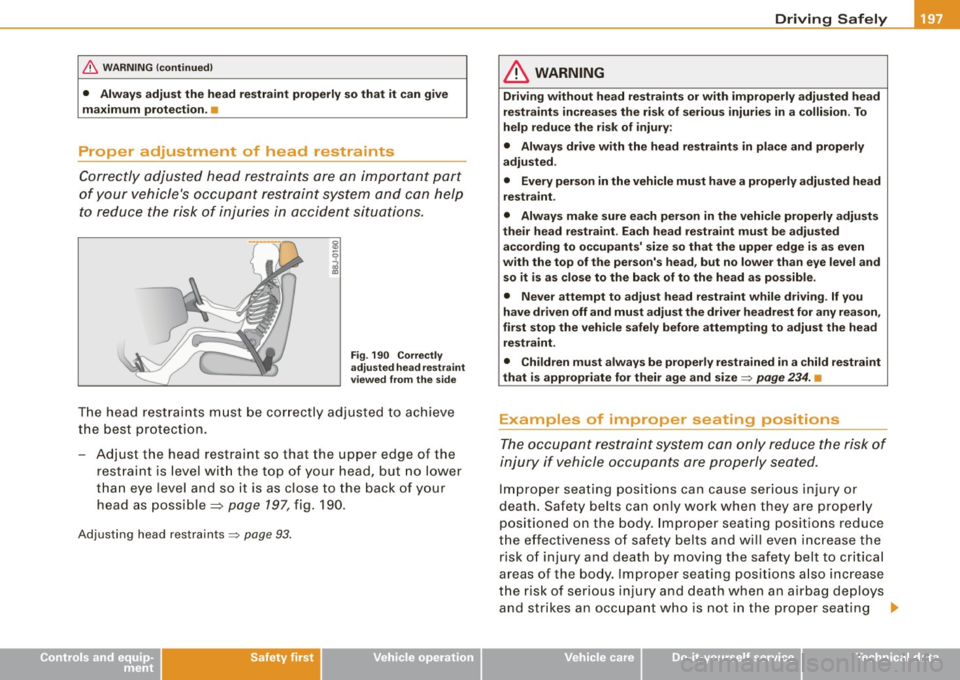
________________________________________________ D_r_iv _ i _n""' g=--- S_ a_ fe~ ly __ !II
& WARNING (continued )
• Always adjust the head restraint properly so that it can give
maximum protection . •
Proper adjustment of head restraints
Correctly adjusted head restraints are an important part
of your vehicle's occupant restraint system and can help
to reduce the risk of injuries in accident situations.
Fig . 190 Correctly
adjusted head restraint
viewed from the side
The head restraints must be correctly adjusted to achieve
the best protection.
- Adjust the head restraint so that the upper edge of the
restraint is level with the top of your head, but no lower
than eye level and so it is as close to the back of your
head as possible :::::,
page 197, fig. 190.
Adjusting head restraints => page 93.
Controls and equip
ment Safety first Vehicle operation
& WARNING
Driving
without head restraints or with improperly adjusted head
restraints increases the risk of serious injuries in a collision. To
help reduce the risk of injury:
• Always drive with the head restraints in place and properly
adjusted .
• Every person in the vehicle must have a properly adjusted head
restraint .
• Always make sure each person in the vehicle properly adjusts
their head restraint. Each head restraint must be adjusted
according to occupants' size so that the upper edge is as even
with the top of the person's head, but no lower than eye level and
so it is as close to the back of to the head as possible .
• Never attempt to adjust head restraint while driving . If you
have driven off and must adjust the driver headrest for any reason ,
first stop the vehicle safely before attempting to adjust the head
restraint.
• Children must always be properly restrained in a child restraint
that is appropriate for their age and size =>
page 234. •
Examples of improper seating positions
The occupant restraint system can only reduce the risk of
injury if vehicle occupants are properly seated.
Improper seating positions can cause serious injury or
death. Safety belts can only work when they are properly
positioned on the body. Improper seating positions reduce
the effectiveness of safety belts and w ill even increase the
risk of injury and death by moving the safety belt to critical
areas of the body. Improper seating positions als o inc rease
the risk of serious injury and death when an airbag deploys and strikes an occupant who is not in the proper seating ..,
Vehicle care Do-it-yourself service Technical data
Page 201 of 390
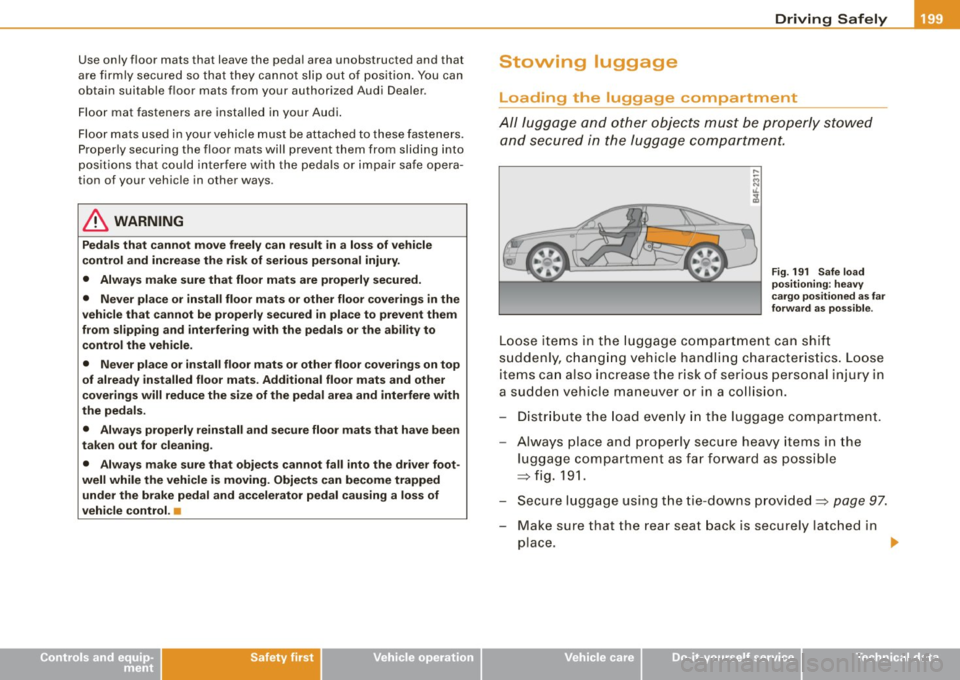
________________________________________________ D_r_iv _ i _n_ g~ S_ a_ fe_ ly __ lffllll
Use only floor mats that leave the pedal area unobstructed and that
are firmly secured so that they cannot slip out of position. You can
obtain suitable floor mats from your authorized Audi Dealer.
Floor mat fasteners are installed in your Audi.
Floor mats used in your vehicle must be attached to these fasteners.
Properly securing the floor mats will prevent them from sliding into
positions that could interfere with the pedals or impair safe opera
tion of your vehicle in other ways .
& WARNING
Pedals that cannot move freely can result in a loss of vehicle
control and increase the risk of serious personal injury.
• Always make sure that floor mats are properly secured.
• Never place or install floor mats or other floor coverings in the
vehicle that cannot be properly secured in place to prevent them
from slipping and interfering with the pedals or the ability to
control the vehicle.
• Never place or install floor mats or other floor coverings on top
of already installed floor mats. Additional floor mats and other
coverings will reduce the size of the pedal area and interfere with
the pedals.
• Always properly reinstall and secure floor mats that have been
taken out for cleaning.
• Always make sure that objects cannot fall into the driver foot
well while the vehicle is moving. Objects can become trapped
under the brake pedal and accelerator pedal causing a loss of
vehicle control. •
Controls and equip ment Safety first Vehicle operation
Stowing luggage
Loading the luggage compartment
All
luggage and other objects must be properly stowed
and secured in the luggage compartment.
Fig. 191 Safe load
positioning: heavy
cargo positioned as far
forward as possible .
Loose items in the luggage compartment can shift
suddenly, changing vehicle handling characteristics . Loose
items can also increase the risk of serious personal injury in
a sudden vehicle maneuver or in a collision.
Distribute the load evenly in the luggage compartment .
- Always place and properly secure heavy items in the
luggage compartment as far forward as possible
::::>fig.191.
Secure luggage using the tie-downs provided=> page 97.
- Make sure that the rear seat back is securely latched in
place.
~
Vehicle care Do-it-yourself service Technical data
Page 203 of 390
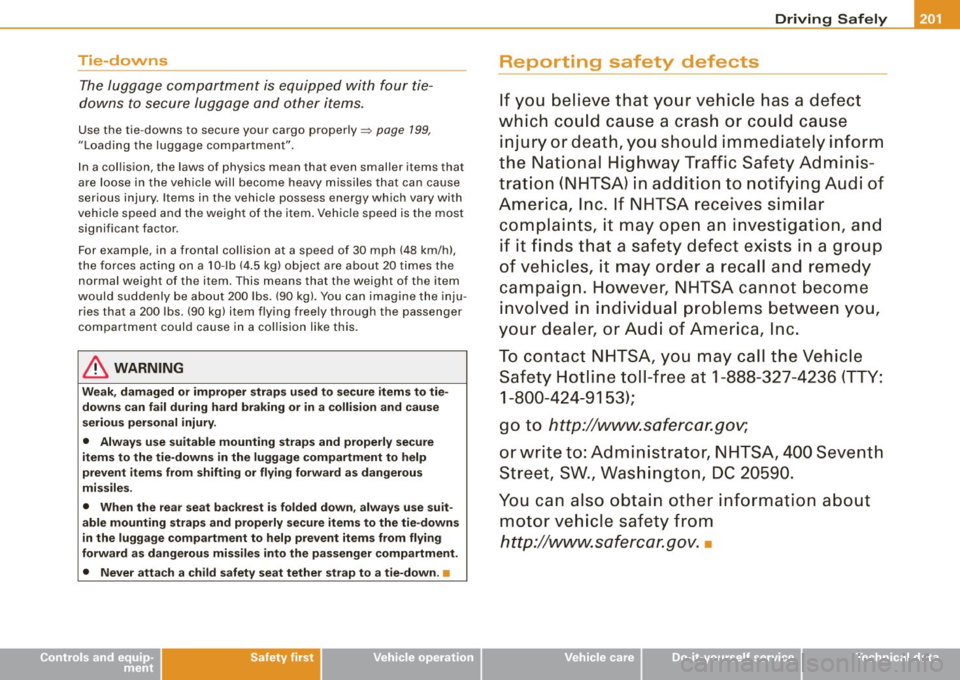
________________________________________________ D_r_iv _ i _n_ g~ S_ a_ fe_ ly __ _
Tie-downs
The luggage compartment is equipped with four tie
downs to secure luggage and other items.
Use the tie -downs to secure your cargo properly~ page 199,
"Loading the luggage compartment".
In a collision, the laws of physics mean that even smaller items that
are loose in the vehicle will become heavy missiles that can cause
serious injury. Items in the vehicle possess energy which vary with
vehicle speed and the weight of the item. Vehicle speed is the most
significant factor.
For example, in a frontal collision at a speed of 30 mph (48 km/h),
the forces acting on a 10-lb (4.5 kg) object are about 20 times the
normal weight of the item. This means that the weight of the item
would suddenly be about 200 lbs. (90 kg). You can imagine the inju
ries that a 200 lbs. (90 kg) item flying freely through the passenger
compartment could cause in a collision like this.
& WARNING
Weak, damaged or improper straps used to secure items to tie
downs can fail during hard braking or in a collision and cause
serious personal injury.
• Always use suitable mounting straps and properly secure
items to the tie-downs in the luggage compartment to help
prevent items from shifting or flying forward as dangerous
missiles.
• When the rear seat backrest is folded down, always use suit
able mounting straps and properly secure items to the tie-downs
in the luggage compartment to help prevent items from flying
forward as dangerous missiles into the passenger compartment.
• Never attach a child safety seat tether strap to a tie-down. •
Controls and equip ment Safety first Vehicle operation
Reporting safety defects
If you believe that your vehicle has a defect
which could cause a crash or could cause
injury or death, you should immediately inform
the National Highway Traffic Safety Adminis
tration (NHTSA) in addition to notifying Audi of
America, Inc. If NHTSA receives similar complaints, it may open an investigation, and
if it finds that a safety defect exists in a group
of vehicles, it may order a recall and remedy
campaign. However, NHTSA cannot become involved in individual problems between you,
your dealer, or Audi of America, Inc.
To contact NHTSA, you may call the Vehicle
Safety Hotline toll-free at 1-888-327-4236 (TTY: 1-800-424-9153);
go to
http://www.safercar.gov;
or write to: Administrator, NHTSA, 400 Seventh Street, SW., Washington, DC 20590.
You can also obtain other information about motor vehicle safety from
http://www.safercar.gov. •
Vehicle care Do-it-yourself service Technical data
Page 205 of 390
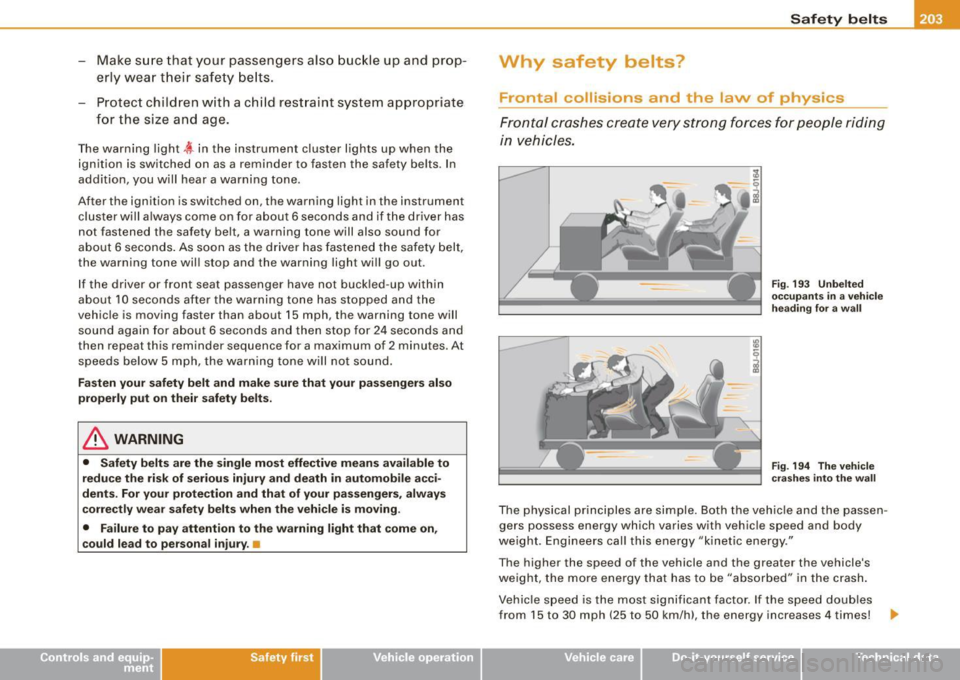
- Make sure that your passengers also buckle up and prop
erly wear their safety belts.
- Protect children with a child restraint system appropriate
for the size and age.
The warning light 4,-in the instrument cluster lights up when the
ignition is switched on as a reminder to fasten the safety belts . In
addition , you will hear a warning tone .
After the ignition is switched on, the warning light in the instrument cluster will always come on for about 6 seconds and if the driver has
not fastened the safety belt , a warning tone will also sound for
about 6 seconds. As soon as the driver has fastened the safety belt,
the warning tone will stop and the warning ligh t will go out .
If the driver or front seat passenger have not buckled -up within
about 10 seconds after the warning tone has stopped and the
vehicle is moving faster than about 15 mph, the warning tone will
sound again for about 6 seconds and then stop for 24 seconds and
then repeat this reminder sequence for a maximum of 2 minutes . At
speeds below 5 mph, the warning tone will not sound.
Fasten your safety belt and make sure that your passengers also
properly put on their safety belts.
& WARNING
• Safety belts are the single most effective means available to
reduce the risk of serious injury and death in automobile acci
dents. For your protection and that of your passengers, always
correctly wear safety belts when the vehicle is moving.
• Failure to pay attention to the warning light that come on,
could lead to personal injury. •
Safety first
Safety belts
Why safety belts?
Frontal collisions and the law of physics
Frontal crashes create very strong forces for people riding
in vehicles.
Fig . 193 Unbelted
occupants in a vehicle
heading for a wall
Fig. 194 The vehicle
crashes into the wall
The physical principles are simple. Both the vehicle and the passen
gers possess energy which varies with vehicle speed and body
weight . Engineers call this energy "kinetic energy."
The higher the speed of the vehicle and the greater the vehicle's
weight, the more energy that has to be "absorbed" in the crash.
Vehicle speed is the most significant factor . If the speed doubles
from 15 to 30 mph (25 to 50 km/h) , the energy increases 4 times!
~
Vehicle care I I Technical data
Page 211 of 390

& WARNING
Improperly positioned safety belts can cause serious personal
injury in an accident.
• Expectant mothers must always wear the lap portion of the
safety belt as low as possible across the pelvis and below the
rounding of the abdomen.
• Always read and heed all WARNINGS and other important infor
mation
=> & in "Fastening safety belts" on page 206. •
Unfastening safety belts
Unbuckle the safety belt with the red release button only
after the vehicle has stopped.
~ .. a,
Fig . 201 Releasing the
tongue from the buckle
- Push the red release button on the buckle~ fig. 201. The
belt tongue will spring out of the buckle
~ & .
- Let the belt wind up on the retractor as you guide the belt
tongue to its stowed position.
& WARNING
Never unfasten safety belt while the vehicle is moving. Doing so
will increase your risk of being injured or killed. •
Safety first
Safety belts
Adjusting safety belt height
With the aid of the safety belt height adjustment, the three
point safety belt strap routing can be fitted to the shoulder
area, according to body size.
Fig . 202 Safety belt
height adjustment for
the front seats -loop
around fittings
Push the loop -around fittings up ~ fig. 202 @, or
- squeeze together the G) button, and push the loop
around fittings
down @.
- Pull the belt to make sure that the upper attachment is
properly engaged.
& WARNING
Always read and heed all WARNINGS and other important informa
tion
=> page 205.
[ i ] Tips
• The shoulder belt part should route approximately over the
middle of your shoulder -under no circumstances should it route
over your neck and throat area=>
& in "Safety belt position" on
page~Z •
•
Vehicle care I I Technical data
Page 213 of 390
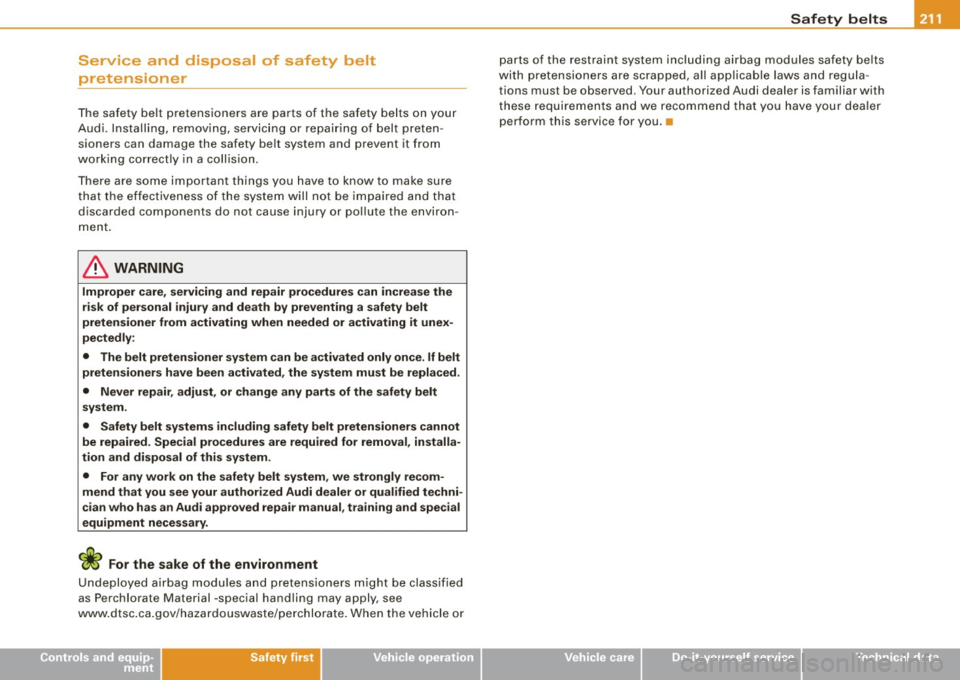
Safety b elts -----------------=------
Service and disposal of safety belt
pretension er
The safety belt pretensioners are parts of the safety belts on your
Audi. Installing, remov ing, servic ing or repair ing of belt preten
sioners can damage the safety be lt system and prevent it from
working correctly in a coll ision.
T here are some important things you have to know to make sure
that the effectiveness of the system will not be impaired and that
discarded components do not cause injury or po llute the environ
ment .
& WARNING
Improper car e, servicing and repair proc edure s can incr ease the
ri sk of p ers onal injury and d eat h by pre venting a safety b elt
pret ensioner from activating whe n ne eded o r activating it un ex
p ec tedly :
• The belt preten sioner sy stem can be activated only once. If belt
p reten sion ers ha ve been activated , the syste m mu st be repl aced.
• Never repair , adju st, or chan ge any parts o f the safet y belt
s y stem .
• Safety belt sy stem s includin g safety belt preten sion ers cannot
be r epaired . Spe cial pro cedure s are requ ired for r emoval , in sta lla
tion and di spo sal of t his sys tem .
• For an y wor k on the safet y be lt sy stem , we strongl y rec om
mend that you see your authori zed Audi de aler or qua lifi ed techni
cian w ho has an Aud i appro ved rep air m anu al, t ra ining a nd spe cial
equipment n ece ssa ry.
W For the sake of the environm ent
Undeployed airbag modu les and pretensioners might be c lassified
as Perchlorate Material -special handling may apply, see
www .dtsc .ca .gov/hazardouswaste/perchlorate. When the vehicle or
Controls and equip ment Safety first Vehicle operation parts of the restraint system including airbag modules safety belts
with pretensioners are scrapped, a ll applicable laws and regu la
tions must be observed. Your authorized Audi dealer is familiar with
these requirements and we recommend that you have your dea ler
perform this service for you. •
Vehicle care Do-it-yourself service Technical data
Page 215 of 390
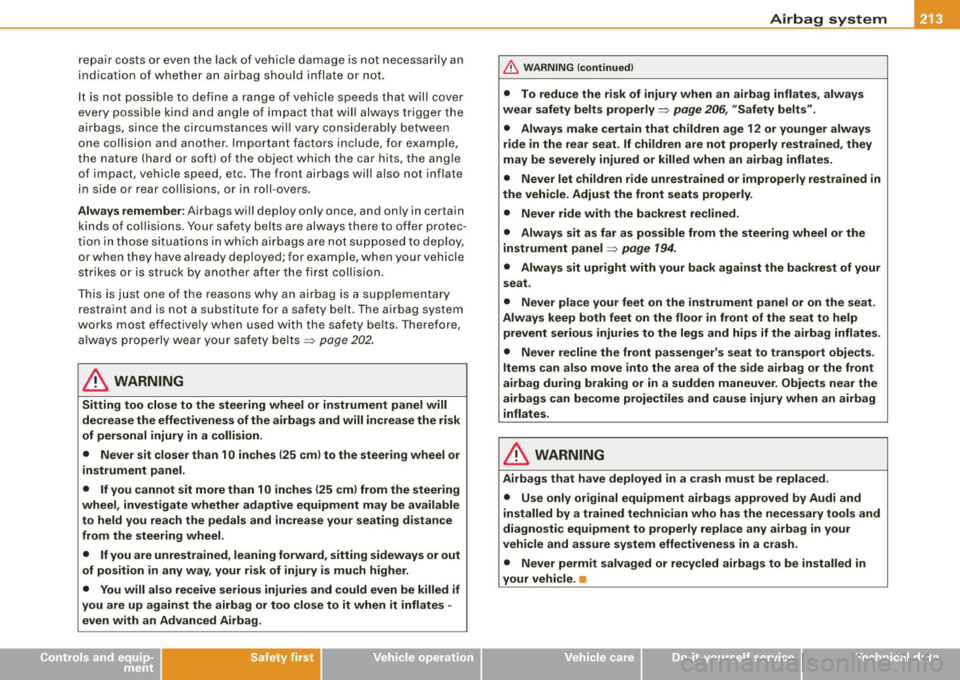
Airbag syst em -----------------=~-
repair costs or even the lack of vehicle damage is not necessari ly an
indication of whether an airbag should inflate or not.
It is not possible to define a range of vehicle speeds that will cover
every possible kind and ang le of impact that wil l always trigger the
airbags, since the circumstances wil l vary considerab ly between
one collision and another. Important factors include, for example,
the nature (hard or so ft) of the object which the car hits, the angle
of impact, vehicle speed, etc. The front airbags wi ll also not inflate
in side or rear co llisions, or in roll -overs .
Al way s rem ember : Airbags wi ll deploy only once, and on ly in certain
kinds of coll isions . Your safety belts are always there to offer protec
tion in those situat ions in wh ich airbags are not supposed to deploy,
or when they have already deployed; for example, when your vehic le
strikes or is struck by another a fter the first coll ision.
T his is just one of the reasons why an airbag is a supplementary
restraint and is not a substitute for a sa fety be lt. The airbag system
works most effectively when used with the safety be lts. Therefore ,
a lways prope rly wea r your safety belt s =>
page 202 .
& WARNING
Sitting too clo se to the steering wheel or in strument panel will
de crease the effect ivene ss of the airbags and will incr ease the risk
of personal injury in a collision.
• Never sit closer than 10 in ches (25 cm) to the steering wheel or
in strument panel.
• If you c annot sit more than 10 in ches (25 cm ) from the steering
wheel , inve stiga te whether adaptive equipment may be available
to held you reach the pedal s and in crease your se ating dist ance
from the steering wheel.
• If you are unrestra ined , leaning forward , sittin g side ways or out
of position in any way , your risk of injury i s much higher .
• You will also receive serious injur ies and could even be killed if
you are up again st the airba g or too clo se to it when it infl ates -
ev en with an Advanced Airbag .
Controls and equip ment Safety first
Vehicle operation
& WAR N IN G ( continued )
• To reduce the ri sk of injury when an airbag inflate s, alw ays
wear safety belt s prope rly~
page 20 6, "S afet y belt s".
• Always make certain that ch ildren age 12 or younger alway s
ride in the rear seat. If children are not p rope rly re str ained , they
may be severely injured or killed when an airbag inflate s.
• Never let children ride unre str ained or impr operly rest rained in
the vehicl e. Adju st the front seat s properly .
• Never ride with the b ackrest r eclined .
• Alway s sit a s far as possible from the steering wheel or the
instrument panel ~
pag e 194.
• Alway s sit upright with your back again st the backre st of your
seat .
• Ne ver pla ce your feet on the instrument panel or on the seat .
Always keep both feet on the floor in front of the seat to help
prevent seriou s injurie s to the leg s and hips if the airbag inflate s.
• Nev er r ecline th e front passenger 's seat to transpo rt obje cts .
Item s can al so mo ve into the area of the side a irbag or the front
airbag during braking or in a sudden m aneuver . Obje cts near the
a irbags can become pro je ctile s and cau se injury when an airbag
inflates .
& WARNING
Airbags that have deployed in a crash must be repla ced.
• U se only original equipment airbags approved by Audi and
in stalled by a trained technician who ha s the neces sary tool s and
diagnostic equipment to properly r epla ce any airb ag in your
vehicle and as sure sy stem effectivenes s in a crash .
• Never perm it salvag ed or re cy cled airb ag s to be i nstall ed in
your vehicle. •
Vehicle care Do-it-yourself service Technical data
Page 217 of 390

Airbag system -----------------=~-rm-I
as defined in the electronic control unit~ page 224, "PASSENGER
AIR BAG OFF l igh t" .
A lways remember, a chi ld safety seat or infant carrier insta lled on
the front seat may be struck and knocked out of position by the
rap id ly i nfl ating pass eng er's ai rbag in a frontal co llision . The airba g
co uld greatly reduce the effectiveness of the chi ld restraint and
even s erio usly in jure the chi ld du ring infl ation.
F or this reason, and because the bac k seat is the safest place for
c h ildr en -w he n prop erly res trained a cc or ding to th eir age an d size
- w e stro ngly recomm end that c hildren a lwa ys s it in th e back seat
~ page 234, "C hil d Safe ty" .
& WARNING
A child in a rearward -facing child safety seat installed on the front
passenger seat will be seriously injured and can be killed if the
front airbag inflates - even with an Advanced Airbag System.
• The inflating ai rbag will hit the child safety seat o r infant
carrier with great force and will smash the child safety seat and
child against the ba ckrest , center arm rest , door or roof.
• Always install rear-facing child safety seats on the rear seat.
• If you must install a rearward facing child safety seat on the
front pa ssenger seat because of exceptional circumstances and
the PASSENGER AIR BAG OFF light does not come on and stay on,
immediately install the rear-facing child safety seat in a rear
seating position and have the airbag system inspected by your
Audi dealer .
• Forward-facing child safety seats installed on the front
pa ssenger's seat may interfere with the deployment of the airbag
and cause serious personal injury to the child .
& WARNING
If, in exceptional circumstances , you must install a forward-facing
child restraint on the front passenger's seat:
Controls and equip ment Safety first
Vehicle operation
& WARNING (continued)
• Always make sure the forward-facing seat has been designed
and certified by its manufacturer for use on a front seat with a
passenger front and side airbag .
• Never put the forward-facing child restraint up against or very
near the instrument panel .
• Always move the passenger seat into its rearmost position in
the seat's fore and aft adjustment range, as far away from the
airbag as possible before installing the forward-facing child
restraint. The backrest must be adjusted to an upright position .
• Make sure that the PASSENGER AIR BAG OFF light comes on
and stays on all the time whenever the ignition is switched on.
& WARNING
To reduce the risk of serious injury , make sure that the PASSENGER
AIR BAG OFF light
will be displayed whenever a child restraint is
installed on the front passenger seat and the ignition is switched
on.
• If the PASSENGER AIR BAG OFF light does not stay on , perform
the checks described
~ page 223 , "Monitoring the Advanced
Airbag System" .
• Take the child restraint off the front passenger seat and install
it properly at one of the rear seat positions if the PASSENGER AIR
BAG OFF light does not stay on .
• Have the airbag system inspected by your Audi dealer immedi
ately .
• Always carefully follow instructions from child restraint manu
facturers when installing child restraints .
& WARNING
If, in exceptional circumstances, you must install a forward or
rearward-facing child restraint on the front passenger's seat :
Vehicle care Do-it-yourself service Technical data
Page 219 of 390

__________________________________________________ A_ i_ r _b _a...; g::- s_ y=--- s_t _e _m __ fflllll
& WA RN ING (co ntinued)
• Airb ag work mo st effectively when u sed with prope rly worn
s afety belts.
• Therefore , alwa ys wear your safety be lt s and make sure that
ev erybod y i n yo ur vehi cle is properly re str ained.
& WARNING
A pe rson on the front pa ssen ger s eat , e spe cially inf ants and small
c hildren , w ill re ceive s eriou s injurie s and can ev en be killed by
being too cl ose to the airbag whe n it infl ates .
• Although the Advan ced Airba g System in your vehicle i s
de signed t o tu rn off the front p assenger airb ag i f a n inf ant or a
s mall child i s on the front pa ssenger seat , nobod y can absolut ely
gu ara nt ee that deployment under these spe cial con ditio ns is
impo ssible in all conc eivable situations that m ay happen during
the useful l ife of your vehic le.
• The Adv anced Airbag Sy stem will deploy in a ccordance with
the "lo w risk" opti on u nder th e U.S. Feder al Stand ard if a child t hat
i s heavier than th e typi cal on e-year old child i s on the front
p asse nger seat and the other conditi ons for airb ag dep loym ent
are met.
• Acc ident stat istics have shown that children are gener ally s afe r
in the rear seat ar ea than in the front seating po sit ion .
• Fo r their o wn safet y, all children , espe cially 12 yea rs and
younger , should always r ide in the back properly restrained for
their age and siz e. •
Advanced front airbag system
Your vehicle is equipped with a front Advanced Airbag System in
compliance with United States Federal Motor Veh icle Sa fety Stan
dard 208 as applicab le at the time your vehicle was manufactured.
Controls and equip ment Safety first Vehicle operation The front Advanced Airbag System supplements the safety belts to
provide additional protection for the driver's and front passenger's
heads and upper bodies in fronta l crashes. The airbags inflate only
in frontal impacts when the vehic le dece leration is high enough.
The front Advanced Airbag System for the front seat occupants is not a substitute for your safety belts. Rather, it is part of the overa ll
occupant restraint system in your vehicle. A lways remember that
the airbag system can only help to protect you, if you are sitting
upright, wear ing your safety belt and wearing it properly . This is why
you and your passengers must a lways be properly restrained, not
just because the law requires you to be .
The Advanced A irbag System in your vehicle has been certified to
meet the " low risk" requirements for 3 and 6 year-o ld children on the
passenger side and very small adults on the driver side. The low risk
deployment criteria are intended to he lp reduce the risk of injury
through interact ion wi th the front a irbag that can occur, for
examp le, by being too close to the steering whee l and instrument
panel when the airbag inflates.
In addition, the system has been certified to comply with the
"suppression" requirements of the Safety Standard, to turn off the
front airbag for infants 12 months old and younger who are restrained on the front passenger seat in child restraints that are
listed in the Standard:::::,
page 236, "Child restraints and Advanced
Airbags".
"Suppression" requires the front ai rbag on the passenger side to be
turned off if:
• a child up to about one year of age is restrained on the front
passenger seat in one of the rear-facing or forward -facing infant
restraints listed in Federal Motor Vehicle Safety Standard 208 with
wh ich the Advanced Airbag System in your vehicle was certif ied. For
a listing of the child restraints that were used to certify your
vehicle's compliance with the US Safety Standard:::::,
page 236,
• weight less than a threshold leve l stored in the control unit is
detec ted on the front passenger sea t. .._
Vehicle care Do-it-yourself service Technical data
Page 221 of 390
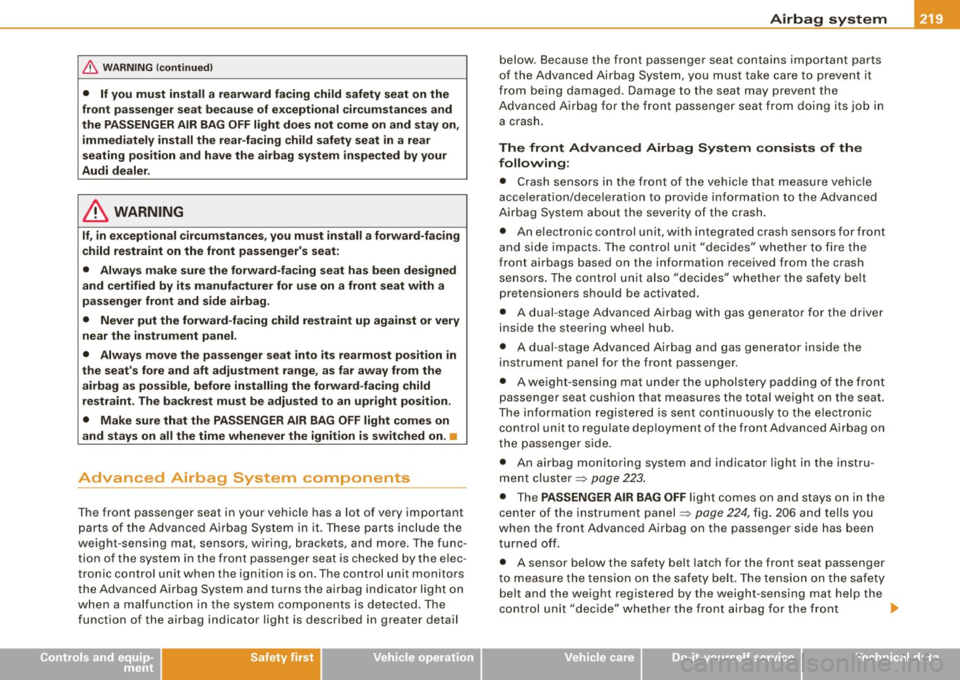
__________________________________________________ A_ i_ r _b _a...; g::- s_ y=--- s_t _e _m __ fllll
& W ARNING (continued )
• If you must in stall a rearward facing child safety seat on the
front passenger seat because of exceptional circumstances and
the PASSENGER AIR BAG OFF light does not come on and stay on ,
immediately install the rear -facing child safety seat in a rear
seating position and have the airbag system inspected by your
Audi dealer .
& WARNING
If, in exceptional circumstance s, you must install a forward-facing
c hild restraint on the front passenger's seat:
• Always make sure the forward -facing seat has been designed
and certified by its manufacturer for use on a front seat with a
passenger front and side airbag .
• Never put the forward -facing child restraint up against or very
near the instrument panel.
• Always move the passenger seat into its rearmost position in
the seat's fore and aft adjustment range , as far away from the
airbag as possible , before installing the forward -facing child
restraint. The backrest must be adjusted to an upright position.
• Make sure that the PASSENGER AIR BAG OFF light comes on
and stays on all the time whenever the ignition is switched on .•
Advanced Airbag System components
T he front passenger seat in your vehicle has a lot of very important
p ar ts of th e A dva nced Air b ag System in it. T hese pa rts inc lu d e the
weight -sensing mat, sensors , w iring, brackets, and more. The func
t ion o f the sys te m in the fr ont passenge r sea t is c hecked by th e e le c
tronic contro l unit when the i gnition is on. The control unit monitors
th e Adva nced Ai rbag Syst em an d t urns t he air b ag in dicat or ligh t on
when a malfunction in the system components is detected. T he
function of the airbag indicator light is described in greater detail
Controls and equip ment Safety first Vehicle operation below
. B ecause the front passenger seat conta ins important par ts
o f th e Adva nced Ai rbag Sys te m , yo u m ust take care to prev ent it
from be ing damaged. Damage to the seat may pr event the
Advanced Air bag for the fr ont pas senge r sea t fr om doing i ts job i n
a cras h.
The front Advanced Airbag System consists of the
following :
• Crash sens ors in th e fro nt of th e vehi cle that meas ure vehic le
acce leration/dece leration to provide information to the Advanced
A irb ag System ab out the seve rity of the c rash .
• An electron ic control unit, with integrat ed crash sensors for front
and si de i mpac ts . T he co ntr ol unit "de cides" w heth er to f ir e th e
front airbags based on th e information received from the crash
se nsors . The con trol unit also "deci des" w hethe r the safet y belt
pretensioners should be activated.
• A dua l- st age A dvan ced Airb ag with gas ge nerato r for t he drive r
inside the steer ing wheel hub .
• A du al- s tage A dvanced Air bag a nd gas gene ra tor insid e the
instrument panel fo r the front passenger.
• A w eigh t-s e nsin g mat und er the u phols ter y padding of th e fron t
passenger seat cushion that measures the total weight on the seat.
Th e in form atio n r egis tered i s sen t co nti nuousl y to th e e lectr oni c
control unit to regu late dep loyment of th e fro nt Advanced Airbag o n
t he pas se nge r sid e.
• An airbag monito ring system and indicator light in the instru
m ent c luste r::::>
p age 22 3.
• T he PASSENGER AIR BAG OFF light comes on and stays on in the
ce nter of the i nstrume nt p anel ::::>
pa ge 224, fi g. 206 a nd tells y ou
when the front Advanced Airbag on the passenger side has been
tu rne d off .
• A sensor be low the safety belt latch for the front seat passenger
to mea sure the t ensio n on t he sa fet y b elt. The ten sion o n the safet y
belt and the weight registe red by t he weight -sensing mat help the
cont ro l un it "deci de" whe ther t he fro nt air bag fo r the front _,.
Vehicle care Do-it-yourself service Technical data